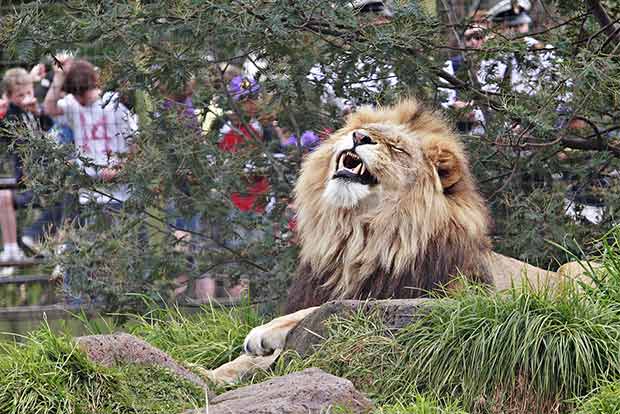Begin typing your search...
Man-animal conflict result of human actions
The increasing instances of animals ‘attacking’ humans in the zoo has turned the spotlight on human attitude which is one of the main reasons for such accidents. Because, an animal doesn’t attack unless provoked and it cannot rationalise between good and bad behaviour while people can.

Chennai
It has been a particularly difficult time for humans and beasts in the last few weeks. Harambe, a captive Western Lowland gorilla, widely held to be an endangered species, was shot and killed by authorities after a toddler fell into a moat in its enclosure at Cincinnati zoo, and Harmabe grabbed the child. A few days later, the video of a lion charging at a boy in a Japan zoo went viral. The boy had been staring at the lion, and when he turned his back, the lion charged at him, but the strong glass wall was an effective barrier.
On June 9, media carried reports of a woman posing in front a tiger enclosure in a Russian zoo. The video records a lot of background noise, while the tiger creeps close to the woman and springs at her, only to be stopped by a glass wall. Closer home in India, there have been many instances of zoo visitors encroaching upon animal enclosures. In March this year, a drunk man jumped into the lion’s enclosure at the Nehru Zoological Park in Hyderabad. He wanted to shake their hands, but luckily, the animals ignored him and the zoo staff pulled him to safety. In April 2015, Rahul Kumar, a drunk teenager suddenly jumped into the lion’s enclosure at the Kamla Nehru Zoo, Ahemdabad, screaming, “Today I kill lion or lion kills me.” Luckily for him, he fell into the second of the seven moats between him and the lions, and was rescued.
Human-animal conflicts in a zoo occur only because of man’s ill-informed behaviour. People wrongly assume that because an animal is in a cage or in an enclosure it cannot attack, and resort to teasing and irritating the animal. Many parents and relatives think it is great fun to frighten a child and hold it over a snake pit in a zoo or say, “See, if you don’t eat your food/be a good boy, that animal will get you,”.
A few go to the other extreme and assume the animal is tame and chuck peanuts and fruits at captive animals. Wild animals are part of our ecosystem. Their conservation is therefore essential for humankind’s survival. There are two kinds of conservation, first of which is in-situ, where planned conservation of animals in their original habitat is undertaken. The other kind is ex-situ, where animals are taken of their habitat and moved to a place which is safer. This happens in plant life as well, which is how botanical gardens came into existence. Zoos therefore play a critical role in conservation.
Zoos are not merely about housing an animal. It is also about propagation of a species. In India, a number of maharajas and lesser royals used to own private zoos. That came to an end after the government took over the same. The Central Zoo Authority was constituted in 1992 by the central government after amendment of the Wildlife Act (Protection) with the objective of restraining unplanned and ill-equipped zoos. The CZA’s guidelines are very strict. There are rules on diet, feeding habits and breeding norms. The design of a zoo is very important.
In South India, the Hyderabad zoo is considered to be very well-designed and maintained, followed by Chennai’s Vandalur Zoo. The late chief minister MG Ramachandran took a personal interest in the design and plan of the zoo. The chief minister is the Chairperson of the zoo, which is a reflection of how much they set store by Vandalur zoo. Exhibition of animals is only one facet of the conservation work that zoos do.
One of the major issues of people visiting a zoo is their attitude. Many people assume that because an animal is confined, they can irritate an animal, or think they can handle it when it reacts. People flash light into the eyes of an animal merely to see how it reacts. In many European countries the zoo keeper is treated with a lot of respect. In many other countries, including India, people treat a zoo like a public space. They eat wherever they like. They make a lot of noise. Animals get irritated by the noise the screeching children make. They do not treat a signage on appropriate behaviour seriously, nor do they pay attention to zoo staff.
Visitors also clamour to see all the exhibits, especially the exotic ones or the new-borns. Total quarantine is recommended for some species, which is not always followed. Resting period of animals (from exhibition) should be part of zoo management. Zoos should have display boards on responsible behaviour. Animal minders should be treated with far more respect by visitors. Every zoo needs not only a vet but one who is also a wildlife expert.
However, despite showing caution and being fully prepared, one can never know what comes out of a forest or from under the water very close to human habitat. An animal by itself will not want to attack humans, only because while attacking, it has to expend a lot of energy. However, it is in the nature of every animal to attack, especially if it is starving. Animals cannot rationalise between good and bad human behaviour.
All of these make zoo management a tough challenge. A zoo houses everything from birds to fruit eating mammals to carnivores in a given area. In a natural setting they may be far apart, but in a zoo they are often in close vicinity, and constantly upgrading the zoo’s design as animals prosper becomes necessary. The disease burden on animals from constant exposure to humans is another task. Increasingly zoo animals are showing a tendency for change of diet. For example, if you feed a python a live chicken every day, it soon begins to show disinterest, much like humans. It wants variety too. A sick animal is not easy to treat as it is not a tractable pet.
Visitors to a zoo do not realise the intricacies of raising and housing wild animals in a zoo. They only want to see the wild animals, take photographs and selfies. One can always build more moats and put up additional fences that keep animals at a safe distance. There is a lot of room for corporates to play a role here as part of conservation efforts since their presence is negligible at present. Finally, what animals want is peace and quiet. It’s up to humans to provide that.
— The author is Managing Trustee, Care Earth
Visit news.dtnext.in to explore our interactive epaper!
Download the DT Next app for more exciting features!
Click here for iOS
Click here for Android
Next Story



